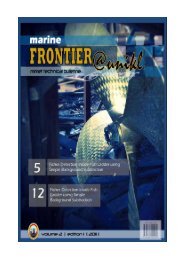click here to download - UniKL MIMET Official Website
click here to download - UniKL MIMET Official Website
click here to download - UniKL MIMET Official Website
You also want an ePaper? Increase the reach of your titles
YUMPU automatically turns print PDFs into web optimized ePapers that Google loves.
Conclusion<br />
3.5<br />
3<br />
2.5<br />
2<br />
1.5<br />
1<br />
0.5<br />
0<br />
(g)<br />
Figure 2: Turning Circle Radius (a) at t = ‐0.5, Reff = 1 (b) at t = ‐0.5, Reff = 1.25 (c)<br />
at t = ‐0.5, Reff = 1.5 (d) at t = ‐0.5, Reff = 1.75 (e) at t = ‐0.5, Reff = 2 (f) at t = ‐0.5,<br />
Reff = 2.25 (g) at t = ‐0.5, Reff = 2.5<br />
It can be concluded that the ship’s directional<br />
stability improves as the trim moves <strong>to</strong>wards<br />
positive values and so do with increasing rudder<br />
and skeg effectiveness. As the ship trimmed<br />
more by the stern (positive trims) and with<br />
increasing rudder and skeg effectiveness, the<br />
wetted surface area of the ship becomes larger.<br />
T<strong>here</strong>fore by virtue of its position, the centroid<br />
of the wetted surface shifts <strong>to</strong>wards aft, the<br />
directional stability increases. The magnitude of<br />
the stability criteria is an indicative of the degree<br />
of the directional stability. The ship is more<br />
directionally stable with numerically higher<br />
values of stability criteria. The negative values of<br />
the stability criteria indicate that the ship is<br />
directionally unstable. The lower the negative<br />
values of the stability criteria, the more unstable<br />
directionally the ship is. It can be deduced that<br />
the ship manoeuvrability increases with<br />
increasing directional stability, turning radius,<br />
positive trim, rudder effectiveness and skeg<br />
effectiveness.<br />
Skeg Effectiveness<br />
<strong>MIMET</strong> Technical Bulletin Volume 1 (2) 2010<br />
Turning Circle Radius<br />
t=-0.5, Reff=2.5<br />
-47.67 -73.00 -98.27 -123.48 -148.62 -173.69 -198.70<br />
Turning Circle Radius (m)<br />
References:<br />
1. R.K Burcher (1971) Development in Ship Manoeuvrability,<br />
Royal Institutions of Naval Architects (RINA).<br />
2. Inou, Hirano and Kajima (1981) Hydrodynamic Derivatives<br />
on Ship Manoeuvring, International Shipbuilding<br />
Progress,<br />
Vol. 20.<br />
3. E. C Tupper (2004) Introduction <strong>to</strong> Naval Architecture, 4 th<br />
Edition, 253‐261.<br />
4. K.J Rawson and E.C Tupper (2001) Basic Ship Theory, Vol.<br />
2, 5 th Edition, 539‐578<br />
5. Toshio ISEKI (2005) Ship Manoeuvrability, Theory and<br />
Assessment, Advanced Topics for Marine Technology by,<br />
Tokyo University of Science and Technology, Japan.<br />
6. Eda H. (1972‐1979) Directional Stability and Control of<br />
Ships in Waves, Journal of Ship Research, Vol. 16, Issue<br />
No. 3, Society of Naval Architects and Marine<br />
Engineers, 205‐218<br />
7. N. Minorsky (2009) Directional Stability of Au<strong>to</strong>matically<br />
Steered Bodies, Journal of the American Society of the<br />
Naval Engineers, Vol. 34, Issue 2, 280‐309<br />
8. Haw L. Wong, Cross Flow Computation for Prediction of<br />
Ship Directional Stability, Hydrodynamics, Theory and<br />
Application, Department of Mechanical<br />
Engineering, University of Hong Kong, Vol. 1, 285‐290<br />
9. B. V. Korvin‐Kroukovsky (2009) Directional Stability and<br />
Steering of Ships in Oblique Waves, Journal of the<br />
American Society of the Naval Engineers, Vol. 73, Issue 3,<br />
483‐487.<br />
10. Ship Fac<strong>to</strong>rs that affect Manoeuvring, SHIPS SALES.COM<br />
| MARINE FRONTIER @ <strong>UniKL</strong><br />
14



